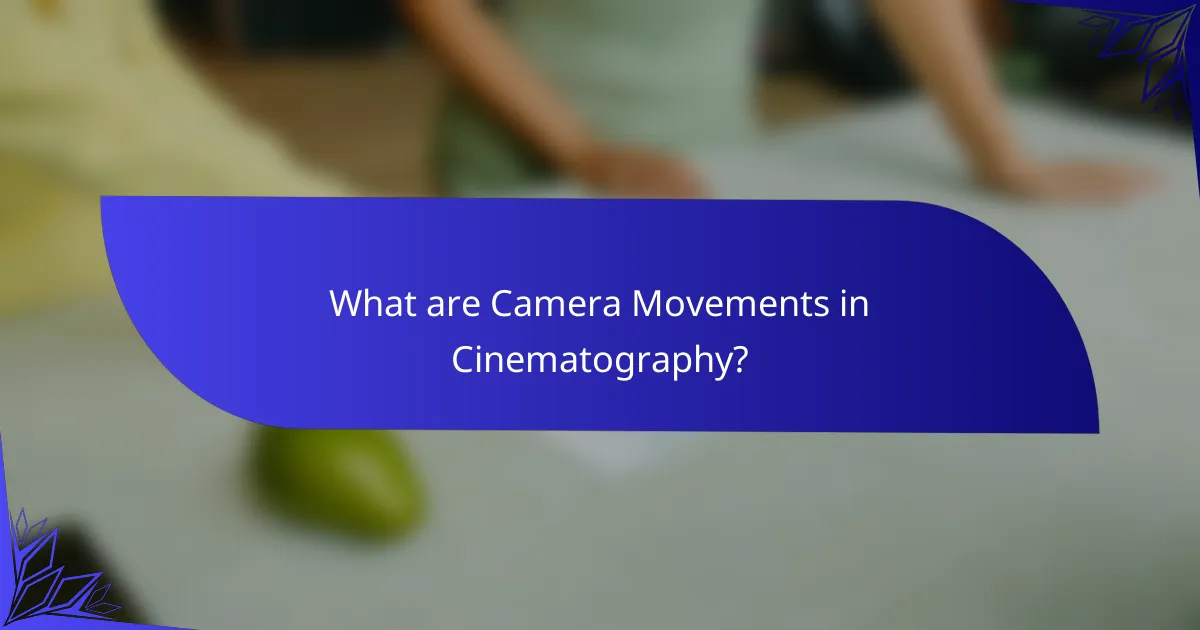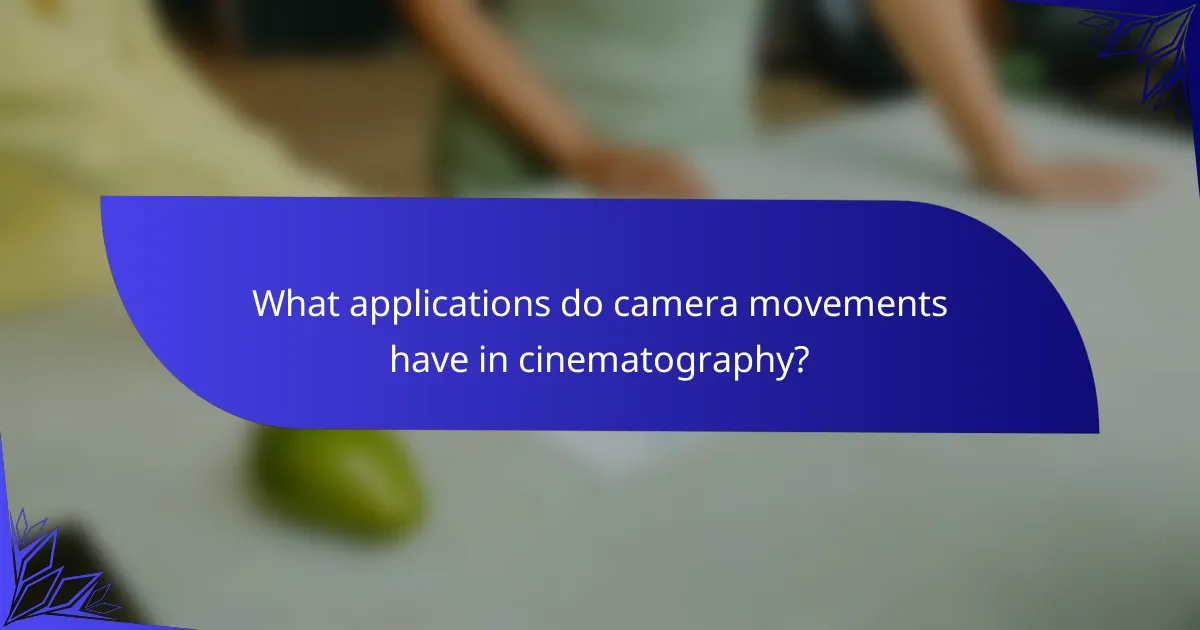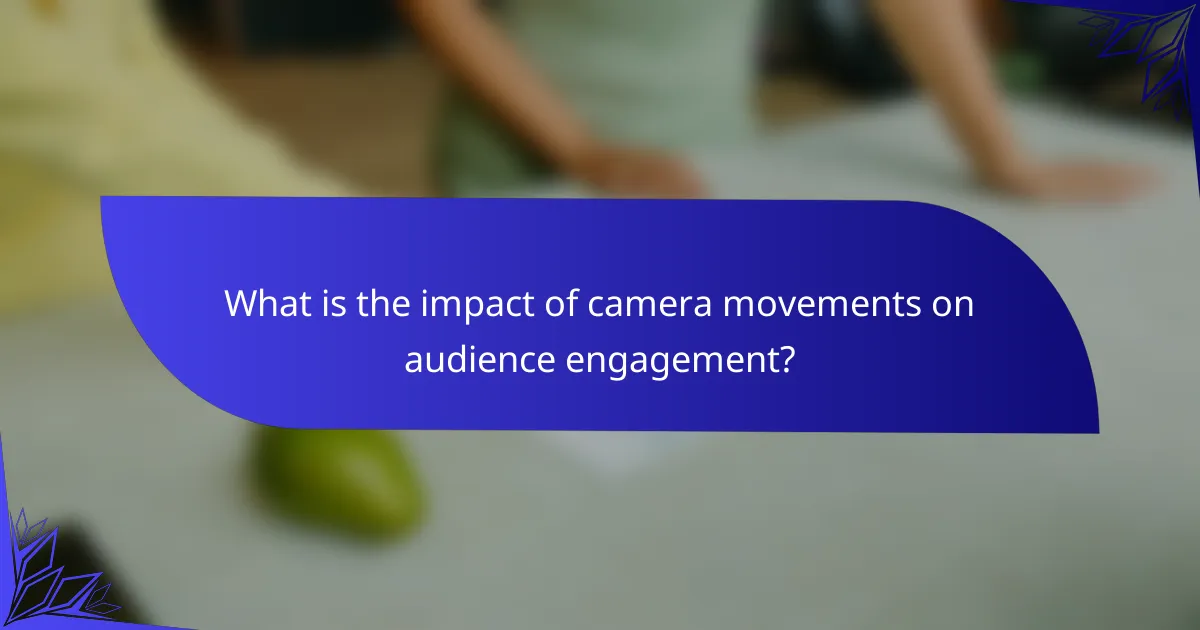Camera movements in cinematography are techniques that alter the position or angle of the camera during a shot, playing a vital role in enhancing storytelling and visual appeal. This article explores various types of camera movements, including pans, tilts, dollies, and cranes, each serving specific purposes in conveying emotion and action. The discussion highlights how these movements guide viewer attention, create emotional responses, and establish spatial relationships within scenes. Additionally, the impact of camera movements on audience engagement is examined, with insights into how dynamic movements can influence narrative perception and emotional reactions.

What are Camera Movements in Cinematography?
Camera movements in cinematography refer to the techniques used to change the position or angle of the camera during a shot. These movements can enhance storytelling and visual appeal. Common types of camera movements include pans, tilts, dollies, and cranes. Panning involves rotating the camera horizontally on a fixed axis. Tilting refers to moving the camera vertically while maintaining a stationary position. Dollies involve moving the camera closer or further from the subject on a wheeled platform. Crane shots elevate the camera above the scene for a wider perspective. Each movement serves a specific purpose in conveying emotion or action. For instance, a dolly-in can create intimacy, while a crane shot can establish grandeur. These movements are essential tools for cinematographers to shape the audience’s experience.
How do camera movements influence storytelling in film?
Camera movements significantly influence storytelling in film by shaping the audience’s emotional response. Different movements convey various narrative tones and perspectives. For instance, a slow pan can create tension or suspense. In contrast, a quick zoom can evoke surprise or urgency. Tracking shots allow viewers to follow characters closely, enhancing empathy. Conversely, static shots may emphasize isolation or stillness. The choice of movement affects pacing and can highlight critical plot points. Research shows that dynamic camera work can enhance viewer engagement, making stories more immersive. Overall, camera movements are essential tools for visual storytelling.
What are the psychological effects of different camera movements?
Different camera movements can evoke specific psychological effects in viewers. For instance, a tracking shot creates a sense of immersion and connection to the subject. This movement allows audiences to follow action closely, enhancing engagement. Conversely, a static shot can evoke feelings of tension or contemplation. It forces viewers to focus on the subject without distraction.
Additionally, a tilt or pan can suggest exploration or discovery. This movement invites viewers to take in a broader context, fostering curiosity. Conversely, rapid movements, such as shakes or zooms, can induce anxiety or excitement. Research indicates that camera movements significantly affect audience emotions and perceptions. For example, a study by T. J. W. van der Voet et al. (2020) found that dynamic camera movements lead to heightened emotional responses in viewers.
How do camera movements enhance visual aesthetics?
Camera movements enhance visual aesthetics by creating dynamic visual narratives. They guide the viewer’s attention and evoke emotional responses. For instance, a slow pan can build tension, while a quick zoom can create excitement. These movements contribute to storytelling by emphasizing key elements in a scene. According to research published in the Journal of Visual Communication, camera movements significantly affect audience engagement and perception. Smooth transitions enhance continuity, while abrupt changes can indicate conflict or surprise. Overall, camera movements are essential tools in cinematography that enrich the visual experience.
What are the different types of camera movements?
The different types of camera movements include pans, tilts, dollies, tracks, cranes, and handheld shots. A pan involves rotating the camera horizontally from a fixed position. A tilt is similar but involves moving the camera vertically. Dollies move the camera closer or further away from a subject. Tracking shots follow the subject’s movement along a path. Cranes elevate the camera for a high-angle shot. Handheld shots create a more intimate, dynamic feel. Each movement serves a specific narrative purpose in cinematography.
What is the significance of static shots compared to dynamic movements?
Static shots provide a stable visual perspective, emphasizing composition and detail. They allow viewers to absorb the scene without distraction. Static shots can evoke a sense of calm or tension, depending on context. In contrast, dynamic movements create energy and momentum. They engage viewers by guiding their attention through action. Research shows that static shots are effective for storytelling, as they enhance emotional connection. Dynamic movements are beneficial for maintaining viewer interest during fast-paced sequences. Both techniques serve unique purposes in cinematography, shaping narrative and viewer experience.
How do pans and tilts differ in their applications?
Pans and tilts serve distinct purposes in cinematography. A pan involves horizontal camera movement, typically used to follow action or reveal new elements in a scene. This technique helps establish spatial relationships between subjects. In contrast, a tilt refers to vertical camera movement, often employed to capture height or depth, such as revealing a tall building or a character’s emotions. Both movements enhance storytelling by guiding the viewer’s attention. Pans are frequent in action sequences, while tilts are common in dramatic moments. Understanding these differences allows filmmakers to choose the appropriate technique for their narrative needs.
What are the unique characteristics of tracking shots?
Tracking shots are characterized by their ability to follow a subject smoothly through space. This movement can be achieved using a camera mounted on a dolly, crane, or steadicam. Tracking shots maintain a consistent frame around the subject, enhancing the viewer’s immersion. They can create a sense of continuity in storytelling by connecting scenes seamlessly. Additionally, tracking shots can vary in speed, from slow, deliberate movements to faster, dynamic sequences. This versatility allows filmmakers to convey different emotions and pacing. The use of tracking shots can also reveal the environment, adding depth to the narrative. Overall, their unique ability to engage viewers through movement distinguishes them in cinematography.
How do zooms affect audience perception?
Zooms affect audience perception by altering the visual focus and emotional engagement with the subject. A zoom-in can create intimacy, drawing viewers closer to the character or action. This technique often heightens emotional responses by emphasizing [censured] expressions or critical details. Conversely, a zoom-out can provide context, showcasing the environment and relationships between characters. This broader perspective can evoke feelings of isolation or vulnerability. Research indicates that zoom levels influence viewer attention and narrative interpretation. For instance, studies show that close-ups enhance empathy while wide shots can create a sense of detachment. Thus, zooms are a powerful tool in shaping how audiences perceive and connect with cinematic narratives.

What applications do camera movements have in cinematography?
Camera movements in cinematography serve multiple applications. They enhance storytelling by guiding the viewer’s attention. For example, a tracking shot can create a sense of immersion in a scene. Additionally, camera movements can convey emotions and character perspectives. A handheld shot may evoke tension or urgency. Conversely, smooth dolly shots can impart a feeling of calm. Furthermore, camera movements can establish spatial relationships within a scene. Panning can reveal the environment and context. Tilting can emphasize verticality or height. Each application of camera movement plays a crucial role in visual narrative and audience engagement.
How do camera movements contribute to genre-specific storytelling?
Camera movements significantly enhance genre-specific storytelling by influencing audience perception and emotional engagement. In horror films, for example, shaky camera movements create tension and unease. This technique immerses viewers in the character’s fear. In contrast, smooth tracking shots in romantic films foster intimacy and connection. These movements allow audiences to experience the characters’ emotions closely. Action films often employ rapid cuts and dynamic camera angles to convey excitement and urgency. This approach keeps viewers on the edge of their seats. Additionally, genres like documentaries utilize static shots to present information clearly. This method emphasizes realism and authenticity. Each genre leverages camera movements to communicate its unique narrative style effectively.
What role do camera movements play in horror films?
Camera movements in horror films create tension and enhance emotional responses. They can manipulate viewer perception and build suspense. For instance, slow tracking shots increase anxiety by prolonging the reveal of a threat. Quick cuts or shaky [censured] techniques can evoke chaos and disorientation. Studies show that camera angles and movements significantly impact audience engagement. A study by the University of Southern California found that specific movements correlate with heightened fear levels. Effective camera work can immerse viewers in the horror experience. Ultimately, camera movements are crucial in shaping the narrative and emotional intensity of horror films.
How are camera movements utilized in action sequences?
Camera movements are essential in action sequences to enhance dynamism and engage viewers. They create a sense of urgency and excitement. Techniques like pans, tilts, and tracking shots are commonly used. These movements can follow characters during chases or highlight intense moments. For instance, a shaky handheld camera can evoke chaos during a fight scene. Smooth tracking shots can build tension as they reveal the environment. Camera movements also help in storytelling by emphasizing emotions and reactions. Research shows that effective camera work significantly impacts audience immersion and perception of the narrative.
What are the technical considerations for executing camera movements?
Technical considerations for executing camera movements include stability, speed, and framing. Stability is crucial to avoid shaky footage. Using tripods or gimbals can enhance stability. Speed of movement affects the visual impact; faster movements can create excitement, while slower movements can build tension. Framing ensures the subject remains in focus and well-composed during movement. Camera settings, such as shutter speed, must match the movement to prevent motion blur. Lighting conditions can also influence camera movement; low light may require slower movements to maintain exposure. Lastly, understanding the movement type, like panning or tilting, is essential for achieving the desired effect in a scene.
What equipment is essential for different types of camera movements?
Essential equipment for different types of camera movements includes tripods, gimbals, sliders, and cranes. Tripods provide stability for static shots and panning movements. Gimbals allow for smooth handheld shots and dynamic movements. Sliders enable controlled lateral movements for tracking shots. Cranes facilitate sweeping motions and high-angle shots. Each piece of equipment enhances specific camera movements, ensuring smooth transitions and professional quality.
How do lighting and composition influence camera movement choices?
Lighting and composition significantly influence camera movement choices in cinematography. Proper lighting can create mood and emphasize subjects, guiding the camera’s movement. For instance, low-key lighting might necessitate slower, more deliberate camera movements to enhance tension. Conversely, bright lighting can support faster, more dynamic movements, reflecting energy. Composition also dictates camera movement; a tightly framed subject may require subtle movements to maintain focus. In contrast, wide compositions allow for sweeping camera movements to capture the environment. These choices are crucial for storytelling, as they affect the audience’s emotional response and engagement with the scene.

What is the impact of camera movements on audience engagement?
Camera movements significantly enhance audience engagement by influencing emotional responses and narrative perception. Dynamic movements, such as pans and tilts, create a sense of immersion. They guide viewer attention and reveal critical details in a scene. Studies indicate that intentional camera movements can heighten tension or excitement. For instance, a study by the University of Southern California found that fast-paced camera movements increase heart rates during action sequences. Smooth tracking shots can evoke feelings of calm and continuity. Overall, effective camera movements are crucial in shaping how audiences connect with the story.
How do camera movements affect emotional responses in viewers?
Camera movements significantly influence emotional responses in viewers. Different movements evoke distinct feelings and enhance storytelling. For instance, a slow zoom can create intimacy, while a rapid pan may generate excitement. Studies show that viewers often feel more engaged during dynamic camera movements. A 2018 study by M. A. K. M. Ali and colleagues found that camera angles and movements impact viewer emotions significantly. This research indicates that specific movements can elicit feelings such as tension or relief. Thus, filmmakers strategically use camera movements to shape audience emotions and enhance narrative impact.
What examples illustrate effective use of camera movements in popular films?
“Goodfellas” effectively uses tracking shots to immerse viewers in the characters’ world. The iconic Copacabana scene features a long take that follows Henry Hill, showcasing the bustling environment. “Birdman” employs continuous shots to create a sense of real-time action. This technique enhances the film’s unique narrative style. “1917” utilizes a single-shot format to convey urgency and realism during World War I. This method captures the intensity of the soldiers’ experiences. “The Shining” showcases the use of slow zooms to build suspense. The focus on characters’ expressions amplifies tension. Each of these films demonstrates how camera movements can enhance storytelling and emotional engagement.
What best practices should filmmakers follow when using camera movements?
Filmmakers should prioritize smoothness and stability when using camera movements. Utilizing stabilizers or gimbals can enhance the fluidity of shots. Planning movements in advance ensures they align with the narrative. Intentional camera movements can evoke specific emotions or reactions in the audience. For instance, a slow zoom can create tension, while a quick pan can convey urgency. Maintaining consistent speed during movements helps avoid jarring transitions. Additionally, considering the framing and composition during movement is crucial for visual storytelling. Filmmakers should also practice and rehearse movements to achieve precision and control.
How can filmmakers effectively plan camera movements for a scene?
Filmmakers can effectively plan camera movements for a scene by defining the desired emotional impact and narrative progression. They should start by analyzing the script and identifying key moments that require emphasis. Next, they can storyboard the scenes to visualize camera angles and movements. Filmmakers should also consider the type of shot, such as close-ups or wide shots, to enhance storytelling. Additionally, they should select appropriate camera equipment, like gimbals or drones, to achieve smooth movements. The use of rehearsals allows filmmakers to refine movements and timing with actors. Finally, reviewing footage during the editing process helps ensure the camera movements align with the intended vision.
What common mistakes should be avoided when executing camera movements?
Common mistakes to avoid when executing camera movements include excessive speed, lack of planning, and poor framing. Excessive speed can create disorienting footage. It is essential to maintain a steady pace to ensure clarity. Lack of planning leads to unintentional shots and wasted resources. A well-thought-out shot list can prevent this issue. Poor framing results in distracting compositions. Proper framing techniques should be applied to enhance visual storytelling. Lastly, ignoring the purpose of the movement can lead to irrelevant shots. Each camera movement should serve a narrative function to maintain viewer engagement.
Camera movements in cinematography are techniques used to change the camera’s position or angle during a shot, significantly enhancing storytelling and visual appeal. This article explores various types of camera movements, including pans, tilts, dollies, and cranes, and their impact on audience engagement and emotional responses. It also examines the psychological effects of different movements, their applications in genre-specific storytelling, and the technical considerations necessary for executing these movements effectively. Additionally, it highlights best practices for filmmakers and common mistakes to avoid, providing a comprehensive understanding of the role of camera movements in visual narratives.